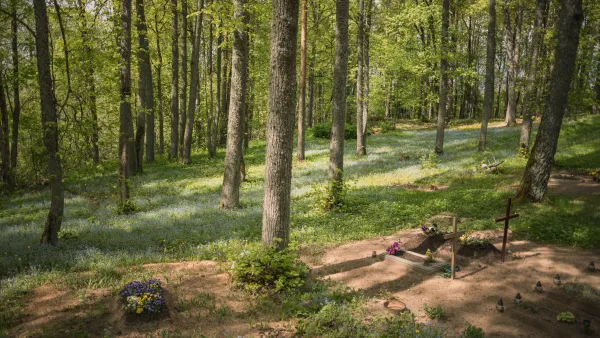The concept of ripeness in several realms is elusive. I have never figured out how to properly thump a melon at a grocery store, although I have made a thorough study of it. You might want to click here, or here, or here for some guidance, none of which seems to work when it’s just me in a stare down with a cold, stone faced and silent honeydew. Just yesterday one of my younger children from what we call the “second litter” asked me at dinner how I could tell if a coconut was ripe. I paused, realized that I had no answer, and did what every good parent should do and asked instead why they weren’t eating their salad. Yes, attack and divert. You think melons and coconuts are tough — try ripeness in land use litigation.
The concept of ripeness in several realms is elusive. I have never figured out how to properly thump a melon at a grocery store, although I have made a thorough study of it. You might want to click here, or here, or here for some guidance, none of which seems to work when it's just me in a stare down with a cold, stone faced and silent honeydew.
Just yesterday one of my younger children from what we call the "second litter" asked me at dinner how I could tell if a coconut was ripe. I paused, realized that I had no answer, and did what every good parent should do and asked instead why they weren't eating their salad. Yes, attack and divert.
You think melons and coconuts are tough - try ripeness in land use litigation.
It has been a battleground in regulatory takings. No one seems to like the current rules. Here's an article which you might find useful for background. Even Professor Daniel R. Mandelker of Washington University in St. Louis, who is a self-styled "police power hawk" (meaning he is almost always on the side of planning, regulation and government), doesn't like the current ripeness rules and testified in the U. S. Congress about what it should do to fix the situation. Professor Mandelker co-hosts IMLA's teleconference series "Mondays with Mandelker and Merriam." Click here for information.
Ripeness is a good defense for government lawyers and ripeness rules do make sense where they prevent a case from being tried prematurely, because it is almost always better for all concerned if property owners and government have an opportunity to resolve their differences. Ripeness, at least as it applies to inverse condemnation, has two prongs. First, the government must reach a final position so that everyone knows what can be approved and what won't be. The second prong is that a property owner must seek compensation in the state courts before proceeding to the federal courts for relief.
That first finality prong of ripeness made its way into litigation under the Religious Land Use and Institutionalized Persons Act (RLUIPA) in the case of Murphy v. New Milford in the Second Circuit.
On Wednesday, the United States Court of Appeals for the Third Circuit handed down a decision in Congregation Anshei Roosevelt v. Planning and Zoning Board of the Borough of Roosevelt in which it adopted the ripeness rule applied in the Murphy case. The lawyer for the Borough of Roosevelt was Professor Marci Hamilton, who will be the guest of Professor Mandelker and me on our IMLA teleconference next Monday, August 3rd. She also represented New Milford in the Second Circuit in the Murphy case.
In Murphy, the complainants were conducting prayer meetings at their home. Those meetings became more frequent and attracted larger numbers of people. The zoning enforcement officer issued a cease and desist order on the ground that the use of the property for a religious institution was not permitted. The Murphys went to federal court and won on their RLUIPA claim. However, the Second Circuit said that the case was not ripe for adjudication because the Murphys had not appealed the cease and desist order or applied for any local zoning relief such as a variance.
In Roosevelt, the Congregation Anshei Roosevelt brought an action in federal district court in New Jersey against the Borough of Roosevelt, its mayor and council, and its planning and zoning board under RLUIPA and state law. The defendants moved to dismiss claiming that the matter was not ripe for judicial review. The federal district court granted the motion to dismiss and on appeal to the United States Court of Appeals for the Third Circuit, that court affirmed the district court's dismissal.
The Congregation established a small New Deal resettlement in the Borough long before zoning was enacted. Under current zoning regulations, the pre-existing, non-conforming synagogue has been allowed to continue.
In 2005, the Congregation entered into an agreement with the Yeshiva under which the Yeshiva would provide the Congregation with rabbinical services and the Congregation in turn would allow the Yeshiva to conduct study and worship activities at the synagogue. The Yeshiva began its operations, a neighbor complained, the zoning officer consulted with the Borough attorney, and it was ultimately decided that the activity could continue as part of the non-conforming use.
Enter the concerned citizens group, the Roosevelt Preservation Association. The Association appealed the zoning officer's decision to the Planning and Zoning Board. Hearings were held. A rabbi testified as to why a Yeshiva is necessarily part of a synagogue, the neighbors testified that there were 34 students enrolled and that those students congregated on the property and the street and that there many cars coming to and from the Yeshiva.
The Board ultimately overturned the decision of the zoning officer and said that the Yeshiva would need a variance to operate there. In the Board's view requiring an application for a variance would not be a substantial burden on the congregation and the Yeshiva.
In the Court of Appeals, the Congregation and the Yeshiva argued that the case was ripe because the Board had reached a final determination on whether the Yeshiva was a house of worship use and therefore permitted as a pre-existing, non-conforming use and that the Board had also decided that the current zoning regulations were applicable to the property.
In handing down its decision, the Court of Appeals noted that ripeness is a jurisdictional inquiry under Article III of the U. S. Constitution. The Court went on to cite the leading inverse condemnation case in this area, Williamson County Regional County Planning Commission v. Hamilton Bank of Johnson, U. S. Supreme Court (1985) and quoted from it noting that the takings claim as decided in that case was "not ripe until the government entity charged with implementing the regulations has reached a final decision regarding the application of the regulations to the property at issue."
The Court of Appeals also cited Murphy and the four reasons for requiring ripeness: it helps develop the full record, it provides the Court with knowledge as to how the regulation will be applied to a particular property, it may avoid litigation all together if the local government gives the relief sought, and it shows "the judiciary's appreciation that land use disputes are uniquely matters of local concern more aptly suited for local resolution."
The Court of Appeals said that the Board had not determined that the Yeshiva was not a permitted use, but had only found that there was a "significant increase in the intensity of that use" and that the variance was necessary to "consider the effect on the neighborhood."
As so the claim that the Board had made a final determination with regard to the application of the zoning rules at this property, the Court discussed the land use aspects of RLUIPA and ultimately determined that "[t]he factual record is not sufficiently developed to decide fully the RLUIPA claim here, and the Board has not issued a definitive position as to the extent the Yeshiva can operate on the synagogue property."
The pièce de résistance is what every local government lawyer and planner likes to hear from a federal court: "Finally, we have stressed ‘the importance of the finality requirement and our reluctance to allow the courts to become super land-use boards of appeals. Land-use decisions concern a variety of interests and persons, and local authorities are in a better position than the courts to assess the burdens and benefits of those varying interests.'"
Time and time again federal courts have stated emphatically that they do not want to be "super land-use boards of appeals," and consequently they have, in most cases, supported ripeness rules that require finality in the decision making process at the local level.
The Third Circuit has marked the decision as "not precedential." However, the Federal Rules of Appellate Procedure were recently amended to allow the decision to be cited.
Rule 32.1 Citing Judicial Dispositions
(a) Citation Permitted. A court may not prohibit or restrict the citation of federal judicial opinions, orders, judgments, or other written dispositions that have been: (i) designated as unpublished, not for publication, nonprecedential, not precedent, or the like; and (ii) issued on or after January 1, 2007. (b) Copies Required. If a party cites a federal judicial opinion, order, judgment, or other written disposition that is not available in a publicly accessible electronic database, the party must file and serve a copy of that opinion, order, judgment, or disposition with the brief or other paper in which it is cited.
The debate continues on how these nonprecedential decisions can be used. http://papers.ssrn.com/sol3/papers.cfm?abstract_id=1280962.
Meanwhile, I will go on mindlessly thumping the honeydews

Analysis: Cybertruck Fatality Rate Far Exceeds That of Ford Pinto
The Tesla Cybertruck was recalled seven times last year.

National Parks Layoffs Will Cause Communities to Lose Billions
Thousands of essential park workers were laid off this week, just before the busy spring break season.

Retro-silient?: America’s First “Eco-burb,” The Woodlands Turns 50
A master-planned community north of Houston offers lessons on green infrastructure and resilient design, but falls short of its founder’s lofty affordability and walkability goals.

Test News Post 1
This is a summary

Analysis: Cybertruck Fatality Rate Far Exceeds That of Ford Pinto
The Tesla Cybertruck was recalled seven times last year.

Test News Headline 46
Test for the image on the front page.
Urban Design for Planners 1: Software Tools
This six-course series explores essential urban design concepts using open source software and equips planners with the tools they need to participate fully in the urban design process.
Planning for Universal Design
Learn the tools for implementing Universal Design in planning regulations.
EMC Planning Group, Inc.
Planetizen
Planetizen
Mpact (formerly Rail~Volution)
Great Falls Development Authority, Inc.
HUDs Office of Policy Development and Research
NYU Wagner Graduate School of Public Service



























